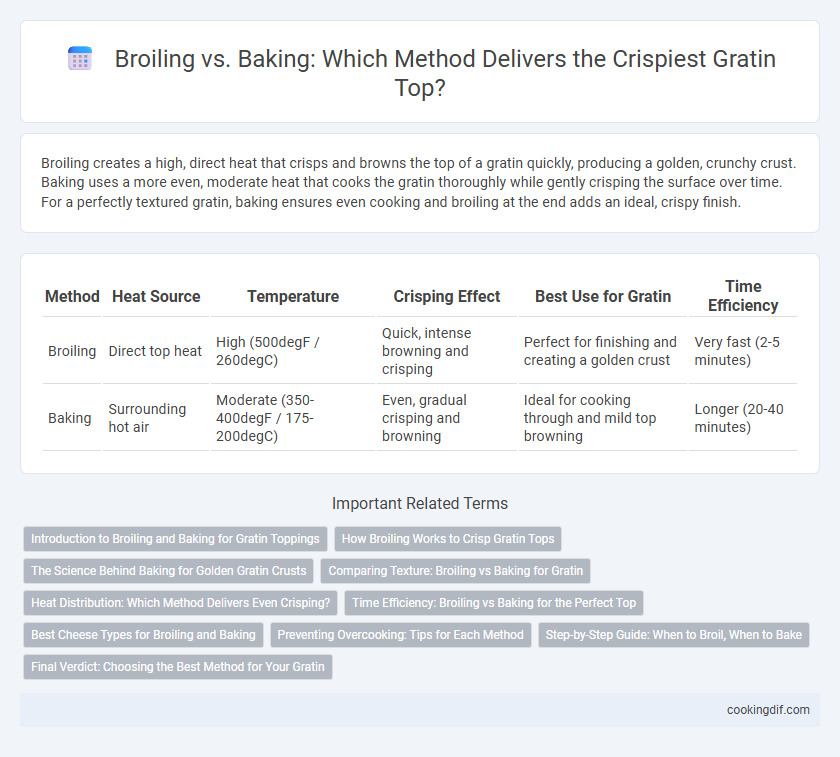Broiling creates a high, direct heat that crisps and browns the top of a gratin quickly, producing a golden, crunchy crust. Baking uses a more even, moderate heat that cooks the gratin thoroughly while gently crisping the surface over time. For a perfectly textured gratin, baking ensures even cooking and broiling at the end adds an ideal, crispy finish.
Table of Comparison
| Method | Heat Source | Temperature | Crisping Effect | Best Use for Gratin | Time Efficiency |
|---|---|---|---|---|---|
| Broiling | Direct top heat | High (500degF / 260degC) | Quick, intense browning and crisping | Perfect for finishing and creating a golden crust | Very fast (2-5 minutes) |
| Baking | Surrounding hot air | Moderate (350-400degF / 175-200degC) | Even, gradual crisping and browning | Ideal for cooking through and mild top browning | Longer (20-40 minutes) |
Introduction to Broiling and Baking for Gratin Toppings
Broiling uses direct high heat from above to quickly crisp and brown gratin toppings, creating a golden crust without overcooking the interior. Baking applies consistent, indirect heat throughout the dish, allowing even cooking and gentle browning that enhances the gratin's creamy texture. Choosing broiling or baking depends on desired texture and timing, with broiling ideal for fast crisping and baking suited for thorough, uniform cooking.
How Broiling Works to Crisp Gratin Tops
Broiling crisps gratin tops by exposing the surface directly to intense radiant heat from above, rapidly caramelizing sugars and browning proteins. This method creates a golden, crunchy crust while maintaining a creamy interior, as the heat doesn't deeply penetrate the dish. Broiling's high temperature and short cooking time efficiently form a flavorful, textured layer that baking alone may not achieve.
The Science Behind Baking for Golden Gratin Crusts
Baking provides even, radiant heat that promotes the Maillard reaction, essential for creating a golden, crispy gratin crust. The steady temperature allows moisture to evaporate slowly from the surface, concentrating sugars and proteins to develop rich flavors and a satisfying texture. Broiling concentrates intense, direct heat, often browning the top quickly but without the same depth of caramelization achieved through gradual baking.
Comparing Texture: Broiling vs Baking for Gratin
Broiling a gratin creates an intense, direct heat that crisps the top layer rapidly, resulting in a darker, crunchy crust with robust caramelization. Baking provides a slower, even heat, allowing the cheese and topping to melt uniformly and develop a golden, slightly softer crust with a tender interior. For a perfectly balanced texture, many chefs start with baking to cook through, then finish with a brief broil to achieve that ideal crispness on top.
Heat Distribution: Which Method Delivers Even Crisping?
Broiling provides intense direct heat from above, resulting in a quickly crisped top but can cause uneven browning if not monitored closely. Baking surrounds the dish with consistent, lower heat, promoting more uniform crisping across the surface. For evenly crisped gratin tops, baking offers superior heat distribution compared to broiling's localized heat source.
Time Efficiency: Broiling vs Baking for the Perfect Top
Broiling crisps the top of a gratin in a matter of minutes by exposing it to intense direct heat, making it the fastest method for achieving a golden-brown crust. Baking requires a longer time as it cooks the gratin evenly throughout, typically taking 30 to 45 minutes, but results in a uniformly cooked dish without risking burning the surface. For optimal time efficiency and a perfectly crisp top, broiling for the last 2 to 5 minutes after baking is recommended.
Best Cheese Types for Broiling and Baking
Broiling and baking are both effective methods for crispening the top of a gratin, with broiling delivering intense direct heat for rapid browning and baking providing even, consistent cooking. Hard cheeses like Gruyere, Parmesan, and aged Cheddar melt well and develop a desirable golden crust when baked, while softer cheeses such as Fontina and Mozzarella create a bubbly and slightly stretchy top ideal for broiling. For optimal gratin results, combining Gruyere for its nutty flavor and excellent melting properties with a sprinkle of Parmesan for added crispness ensures a perfectly textured and flavorful crust.
Preventing Overcooking: Tips for Each Method
Broiling crisps the gratin's top quickly by exposing it to intense direct heat, so monitor closely to prevent overcooking or burning. Baking cooks more evenly at moderate temperatures, allowing gradual browning; cover with foil if the top browns too fast before the interior is done. To avoid overcooking, use a timer for broiling and check doneness often, while for baking, adjust oven temperature and time based on dish thickness and ingredients.
Step-by-Step Guide: When to Broil, When to Bake
Broil gratin dishes during the final 2-5 minutes of cooking to achieve a golden, crispy top without overcooking the interior. Bake the gratin at 350degF (175degC) for 30-45 minutes to ensure even cooking and creamy texture throughout. Use broiling selectively under close supervision to prevent burning while baking provides consistent heat for thorough cooking.
Final Verdict: Choosing the Best Method for Your Gratin
Broiling crisps the top of a gratin quickly, creating a golden-brown, crunchy layer ideal for dishes that require immediate serving. Baking ensures even heat distribution, allowing the gratin to cook thoroughly while slowly achieving a crispy top, perfect for deeper casseroles and richer textures. For the best result, use baking for a fully cooked interior and finish with broiling to achieve a perfectly crisped, golden crust.
Broiling vs baking for crisping top Infographic

 cookingdif.com
cookingdif.com